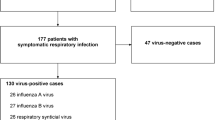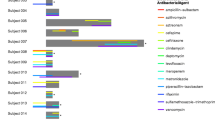Abstract
Purpose
The respiratory tract microbiota are deemed as the gatekeeper to health. Consequently, microbiota dysbiosis can lead to the development of diseases. To identify the exact origins of the localized pathogenic bacteria, we investigated bacterial composition in the upper airway tract.
Methods
Separate mucosal swabs were collected from nostril or oropharynx of each participant. Meanwhile, the lymphoid tissues including adenoids and tonsils were collected during operation. DNAs were exacted from all the samples for the following 16S rRNA analysis.
Results
At the phylum level, the basic bacterial structures in the adenoids, tonsils, oropharynx, and nostrils were generally similar: five main phyla Firmicutes, Proteobacteria, Bacteroidetes, Actinobacteria, and Fusobacteria form the majority of the microbiota. However, across these four sites, the microbiota composition differed. More specifically, the bacterial composition in the nostrils was unique. There, Firmicutes and Actinobacteria were the most abundant phyla, while Bacteroides and Fusobacteria were the least abundant. At the genus level, Staphylococcus, Dolosigranulum, Corynebacterium, and Moraxella were the most plentiful, while Fusobacteria was the least ample. Across all sites, Streptococcus displayed similar abundances. Fusobacteria exhibited higher abundances in the lymphoid tissues and oropharynx. Haemophilus and Neisseria were more plentiful in the tonsils and oropharynx. Notably, Klebsiella, which is normally localized to the gut, was abundant in the adenoids and tonsils.
Conclusion
Our data indicate that promising pathogenic bacteria originate from all sites in the upper airway. The upper tract lymphoid tissues, normally considered as immune organs, may also serve as reservoirs for pathogenic bacteria.





Similar content being viewed by others
References
Ari O, Karabudak S, Kalcioglu MT, Gunduz AY, Durmaz R (2019) The bacteriome of otitis media with effusion: does it originate from the adenoid? Int J Pediatr Otorhinolaryngol. https://doi.org/10.1016/j.ijporl.2019.109624
Bell JS, Spencer JI, Yates RL, Yee SA, Jacobs BM, DeLuca GC (2019) Invited review: from nose to gut—the role of the microbiome in neurological disease. Neuropathol Appl Neurobiol 45:195–215
Bomar L, Brugger SD, Lemon KP (2018) Bacterial microbiota of the nasal passages across the span of human life. Curr Opin Microbiol 41:8–14
Chan CL, Wabnitz D, Bardy JJ, Bassiouni A, Wormald PJ, Vreugde S, Psaltis AJ (2016) The microbiome of otitis media with effusion. Laryngoscope 126:2844–2851
Coleman A, Wood A, Bialasiewicz S, Ware RS, Marsh RL, Cervin A (2018) The unsolved problem of otitis media in indigenous populations: a systematic review of upper respiratory and middle ear microbiology in indigenous children with otitis media. Microbiome 6:199
Dimitri-Pinheiro S, Soares R, Barata P (2020) The microbiome of the nose-friend or foe? Allergy Rhinol (Providence) 11:2152656720911605
Fago-Olsen H, Dines LM, Sorensen CH, Jensen A (2019) The adenoids but not the palatine tonsils serve as a reservoir for bacteria associated with secretory otitis media in small children. mSystems. https://doi.org/10.1128/mSystems.00169-18
Giebink GS, Juhn SK, Weber ML, Le CT (1982) The bacteriology and cytology of chronic otitis media with effusion. Pediatr Infect Dis 1:98–103
Hilty M, Qi W, Brugger SD, Frei L, Agyeman P, Frey PM, Aebi S, Muhlemann K (2012) Nasopharyngeal microbiota in infants with acute otitis media. J Infect Dis 205:1048–1055
Hoedemaekers A, Schulin T, Tonk B, Melchers WJ, Sturm PD (2006) Ventilator-associated pneumonia caused by dolosigranulum pigrum. J Clin Microbiol 44:3461–3462
Jensen A, Fago-Olsen H, Sorensen CH, Kilian M (2013) Molecular mapping to species level of the tonsillar crypt microbiota associated with health and recurrent tonsillitis. PLoS ONE. https://doi.org/10.1371/journal.pone.0056418
Johnston J, Hoggard M, Biswas K, Astudillo-Garcia C, Radcliff FJ, Mahadevan M, Douglas RG (2019) Pathogen reservoir hypothesis investigated by analyses of the adenotonsillar and middle ear microbiota. Int J Pediatr Otorhinolaryngol 118:103–109
Johnston JJ, Douglas R (2018) Adenotonsillar microbiome: an update. Postgrad Med J 94:398–403
Kelly D, Yang L, Pei Z (2018) Gut microbiota, fusobacteria, and colorectal cancer. Diseases 6:109
Krismer B, Weidenmaier C, Zipperer A, Peschel A (2017) The commensal lifestyle of staphylococcus aureus and its interactions with the nasal microbiota. Nat Rev Microbiol 15:675–687
Kumpitsch C, Koskinen K, Schopf V, Moissl-Eichinger C (2019) The microbiome of the upper respiratory tract in health and disease. BMC Biol 17:87
Lecuyer H, Audibert J, Bobigny A, Eckert C, Janniere-Nartey C, Buu-Hoi A, Mainardi JL, Podglajen I (2007) Dolosigranulum pigrum causing nosocomial pneumonia and septicemia. J Clin Microbiol 45:3474–3475
Lemon KP, Klepac-Ceraj V, Schiffer HK, Brodie EL, Lynch SV, Kolter R (2010) Comparative analyses of the bacterial microbiota of the human nostril and oropharynx. MBio 1:e00129-e210
Liu Q, Liu Q, Meng H, Lv H, Liu Y, Liu J, Wang H, He L, Qin J, Wang Y, Dai Y, Otto M, Li M (2020) Staphylococcus epidermidis contributes to healthy maturation of the nasal microbiome by stimulating antimicrobial peptide production. Cell Host Microbe 27:68–78
Ma YX, Wang CY, Li YY, Li J, Wan QQ, Chen JH, Tay FR, Niu LN (2020) Considerations and caveats in combating eskape pathogens against nosocomial infections. Adv Sci (Weinh) 7:1901872
Mahdavinia M, Engen PA, LoSavio PS, Naqib A, Khan RJ, Tobin MC, Mehta A, Kota R, Preite NZ, Codispoti CD, Tajudeen BA, Schleimer RP, Green SJ, Keshavarzian A, Batra PS (2018) The nasal microbiome in patients with chronic rhinosinusitis: Analyzing the effects of atopy and bacterial functional pathways in 111 patients. J Allergy Clin Immunol 142:287–290
Man WH, de Steenhuijsen Piters WA, Bogaert D (2017) The microbiota of the respiratory tract: Gatekeeper to respiratory health. Nat Rev Microbiol. https://doi.org/10.1038/nrmicro.2017.14
Marchica CL, Dahl JP, Raol N (2019) What’s new with tubes, tonsils, and adenoids? Otolaryngol Clin North Am 52:779–794
Marcus CL, Brooks LJ, Draper KA, Gozal D, Halbower AC, Jones J, Schechter MS, Sheldon SH, Spruyt K, Ward SD, Lehmann C, Shiffman RN (2012) Diagnosis and management of childhood obstructive sleep apnea syndrome. Pediatrics 130:576–584
Minami SB, Mutai H, Suzuki T, Horii A, Oishi N, Wasano K, Katsura M, Tanaka F, Takiguchi T, Fujii M, Kaga K (2017) Microbiomes of the normal middle ear and ears with chronic otitis media. Laryngoscope 127:E371–E377
Miura MS, Mascaro M, Rosenfeld RM (2012) Association between otitis media and gastroesophageal reflux: a systematic review. Otolaryngol Head Neck Surg 146:345–352
Murphy TF, Parameswaran GI (2009) Moraxella catarrhalis, a human respiratory tract pathogen. Clin Infect Dis 49:124–131
Nistico L, Kreft R, Gieseke A, Coticchia JM, Burrows A, Khampang P, Liu Y, Kerschner JE, Post JC, Lonergan S, Sampath R, Hu FZ, Ehrlich GD, Stoodley P, Hall-Stoodley L (2011) Adenoid reservoir for pathogenic biofilm bacteria. J Clin Microbiol 49:1411–1420
Oshima N, Hamada H, Hirose S, Shimoyama K, Fujimori M, Honda T, Yasukawa K, Ishiwada N, Ohkusu M, Takanashi JI (2021) Panton-valentine leukocidin-positive novel sequence type 5959 community-acquired methicillin-resistant staphylococcus aureus meningitis complicated by cerebral infarction in a 1-month-old infant. J Infect Chemother 27:103–106
Parlet CP, Brown MM, Horswill AR (2019) Commensal staphylococci influence staphylococcus aureus skin colonization and disease. Trends Microbiol 27:497–507
Perry M, Whyte A (1998) Immunology of the tonsils. Immunol Today 19:414–421
Pettigrew MM, Laufer AS, Gent JF, Kong Y, Fennie KP, Metlay JP (2012) Upper respiratory tract microbial communities, acute otitis media pathogens, and antibiotic use in healthy and sick children. Appl Environ Microbiol 78:6262–6270
Ramsey MM, Freire MO, Gabrilska RA, Rumbaugh KP, Lemon KP (2016) Staphylococcus aureus shifts toward commensalism in response to corynebacterium species. Front Microbiol 7:1230
Ren T, Glatt DU, Nguyen TN, Allen EK, Early SV, Sale M, Winther B, Wu M (2013) 16s rrna survey revealed complex bacterial communities and evidence of bacterial interference on human adenoids. Environ Microbiol 15:535–547
Sarmiento Varon L, De Rosa J, Rodriguez R, Fernandez PM, Billordo LA, Baz P, Beccaglia G, Spada N, Mendoza FT, Barberis CM, Vay C, Arabolaza ME, Paoli B, Arana EI (2021) Role of tonsillar chronic inflammation and commensal bacteria in the pathogenesis of pediatric osa. Front Immunol. https://doi.org/10.3389/fimmu.2021.648064
Schwengel DA, Dalesio NM, Stierer TL (2014) Pediatric obstructive sleep apnea. Anesthesiol Clin 32:237–261
Subtil J, Rodrigues JC, Reis L, Freitas L, Filipe J, Santos A, Macor C, Duarte A, Jordao L (2017) Adenoid bacterial colonization in a paediatric population. Eur Arch Otorhinolaryngol 274:1933–1938
Ta LDH, Yap GC, Tay CJX, Lim ASM, Huang CH, Chu CW, De Sessions PF, Shek LP, Goh A, Van Bever HPS, Teoh OH, Soh JY, Thomas B, Ramamurthy MB, Goh DYT, Lay C, Soh SE, Chan YH, Saw SM, Kwek K, Chong YS, Godfrey KM, Hibberd ML, Lee BW (2018) Establishment of the nasal microbiota in the first 18 months of life: Correlation with early-onset rhinitis and wheezing. J Allergy Clin Immunol 142:86–95
Uehara Y, Nakama H, Agematsu K, Uchida M, Kawakami Y, Abdul Fattah AS, Maruchi N (2000) Bacterial interference among nasal inhabitants: Eradication of staphylococcus aureus from nasal cavities by artificial implantation of corynebacterium sp. J Hosp Infect 44:127–133
Vanneste P, Page C (2019) Otitis media with effusion in children: Pathophysiology, diagnosis, and treatment. A review J Otol 14:33–39
Vickery TW, Ramakrishnan VR, Suh JD (2019) The role of staphylococcus aureus in patients with chronic sinusitis and nasal polyposis. Curr Allergy Asthma Rep 19:21
Winther B, Gross BC, Hendley JO, Early SV (2009) Location of bacterial biofilm in the mucus overlying the adenoid by light microscopy. Arch Otolaryngol Head Neck Surg 135:1239–1245
Wu BG, Sulaiman I, Wang J, Shen N, Clemente JC, Li Y, Laumbach RJ, Lu SE, Udasin I, Le-Hoang O, Perez A, Alimokhtari S, Black K, Plietz M, Twumasi A, Sanders H, Malecha P, Kapoor B, Scaglione BD, Wang A, Blazoski C, Weiden MD, Rapoport DM, Harrison D, Chitkara N, Vicente E, Marin JM, Sunderram J, Ayappa I, Segal LN (2019) Severe obstructive sleep apnea is associated with alterations in the nasal microbiome and an increase in inflammation. Am J Respir Crit Care Med 199:99–109
Acknowledgements
This study was supported by the Cooperative research promotion plan of basic medicine and clinical medicine of Anhui Medical University (2020XKjT036), the National Natural Science Foundation of China (grant 81772139, 82072235), Shanghai Rising-Star Program (20QA1405900), the Shanghai Committee of Science and Technology, China (grant 20ZR1432800).
Author information
Authors and Affiliations
Corresponding authors
Ethics declarations
Conflicts of interest
The authors declare no conflict of interest.
Additional information
Publisher's Note
Springer Nature remains neutral with regard to jurisdictional claims in published maps and institutional affiliations.
Supplementary Information
Below is the link to the electronic supplementary material.
Rights and permissions
About this article
Cite this article
Cao, W., Sun, Y., Zhao, N. et al. Characteristics of the bacterial microbiota in the upper respiratory tract of children. Eur Arch Otorhinolaryngol 279, 1081–1089 (2022). https://doi.org/10.1007/s00405-021-07013-y
Received:
Accepted:
Published:
Issue Date:
DOI: https://doi.org/10.1007/s00405-021-07013-y




